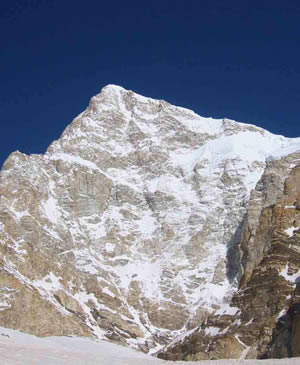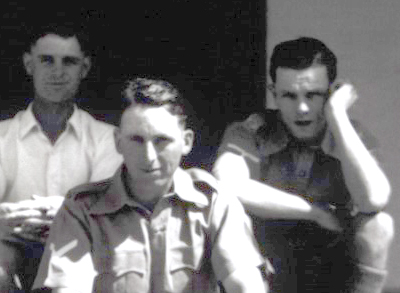THE ICE SOLDIERS
Ralph (Joe) Ridley
Henery Joseph Bull
Sidney Frederic Hillier
John Alfred Williams
Lionel James Hamilton

|
THE ICE SOLDIERS Ralph (Joe) Ridley Henery Joseph Bull Sidney Frederic Hillier John Alfred Williams Lionel James Hamilton |

|
|
|
|
This web page is the result of the research of Paul Rogers of the Blackpool and The Fylde College and Peter Osborne, Librarian of the Fell and Rock Climbing Club of The University of Lancaster. The research of Mr. Osborne and Mr. Rogers resulted in an exhibition at the Millais Gallery in Southampton form 26 June to 26 July of 2003. My sister Ann Cording (daughter of Ralph Ridley) was gathering information on the 1937 Kamet expedition and as luck would have it came across a web page for the exhibition at the Millais Gallery. Ann gave me her findings and the Catalog of the exhibit for Christmas off 2004. And here we are, a web page I’m hoping someone will stumble across who can shed some light on the Ice Soldiers. A long shot for sure but who knows?
Should you find yourself viewing this page and have any information on the men or the Mt Kamet The following frame is an extract form the Millais Gallery Exhibition catalog and tells the story of Mr. Osborne and Mr. Rogers research. |
|
This catalogue tells of a tale in a tobacco tin, or rather, three tobacco tins (1). Given to Paul
Rogers when the Grundy House Museum at Blackpool was closed in 1980, the tins contained photographic
negatives. The top pictures, of soldiers sitting in a row, proved less than interesting, and the tins
were put by. Only when, a few years later, he looked again, was his interest aroused by photographs
of the same men on a snowy peak. Who and where were they? Closer inspection of the negatives gave
the first important clues. One photograph (Plate 20 ) showed soldiers with a hand-lettered sign at
their feet: "TO KAMET - KEEP LEFT". Kamet was famous in the 1930s. When scaled by F Smythe and party
in 1931, it was the highest mountain yet climbed, and the ascent was as much a matter of pride to the
British in the '30s as was Everest in the '50s. The soldiers had attempted to climb it; another image
gave a clue to their identity. It bore the label "East Surrey Regiment". The Tobacco tins became a
research project at Blackpool and Fylde College. Early contact was made with the Regimental Museum at
Clandon Park, near Guildford. By coincidence the Director, Penny James, had recently looked at material
relating to the event. She knew the names of the men and that their journey had been made in 1937.
Furthermore the leader, Corporal Ridley, had kept a journal, extracts from which had been printed in
the Regimental Journal. Mrs James sent a copy. The outline of the expedition as given by Ridley are
summarised in "The Expedition". There was little hope of finding more of the Journal, which was
probably destroyed with regimental records, when the East Surreys were amalgamated into the Surrey
Regiment in 1953. Also there were unanswered questions: whence the photographs in Blackpool; why
the expedition; what else was known about the soldiers; what exactly do the photographs show? The
first question has not been answered. Those from Blackpool taking mountain photographs at the time,
including Everest photographer Alf Gregory, knew nothing of the images. Evidently fellow soldiers
were given copies of them. For example an album with small prints in the Museum belonged to Albert
Skinner, who was at Fyzabad with the East Surreys in 1937. It is possible that the negatives remained
the property of one of the climbers, "Pinky" Williams ( 2), who was repatriated to a Morecambe address
on 30.10.1945. Some of the answers to the other questions emerged from numbers of the regimental
Journal and Regimental History, as well as from newspaper articles and contact with contemporary
soldiers. What is known of the expedition is outlined below as is information so far discovered
about the men.
Footnotes: 1. The tins were Players Navy Cut ( mentioned by the soldier/climbers) Ardath and Lambert and Butler. 2. The nickname was common for Williamses; it came from that then popular medicament 'Dr. Williams' Pink Pills for Pale and Languid Ladies'. |
|
Ralph (Joe) Ridley |

May 3rd 1937. Pte S. Hillier,L/Cpl H. Bull Cpl R. Ridley, L/Cpls L Hamilton,and J. Williams. | |
|
Click for info on Ralph (Joe) Ridley | ||
|
Sidney Frederic Hillier | ||
|
Click for info on Sidney Frederic Hillier |
||
|
Henry Joseph Bull |

While not of the best quality this photo does show the facial features of three of the men Clip from a larger image take on the trek to Kamet. |
|
|
Click for info on Henry Joseph Bull |
||
|
John Alfred Williams | ||
|
Click for info on John Alfred Williams |
||
|
James Hamilton | ||
|
Click for info on James Hamilton |
||
The Expedition.
The following two images show the men resting as they approached Meade's Col (7138m) and a modern day expedition at about the same location |

|

|
|
|
|
Paul Rogers research / Millais Gallery Exhibition Reading this provides a good indication into the inspiration for the expedition and a trip planning overview | ||||||||
View photographs take by the men of the expedition
| ||||||||
|
The 1936 trek part of the plan
The full account of the 1936 trek, as published in the regimental journal can be found here. On reading this one reasonably concludes that this trek was a test of logistics for the 1937 Kamet Expedition | ||||||||
|
Planning The Trip The above link will provide information on the actual planning for the Expedition
"All the skill, courage, and foresight will avail nothing if the himalayas is in a bad
Also the fact that tobacco was considered an essential. | ||||||||
|
The Trek to Kamet, May 3 to May 23 1937 | ||||||||
|
Camp 1, May 25 to May 27 1937 | ||||||||
|
Camp 2 & 3, May 28 to June 3 1937
Syd tells me that the porters would be willing to stand by us and go farther up, but we all agree
it is better to keep to our plan of carrying on alone from here. Whatever happens we involve no
one but ourselves. Excellent fellows though, these porters. Willing and loyal to the core. Their
work has been of the greatest possible assistance to us.
| ||||||||
|
June 4th to June 10th Camp 4 1937 | ||||||||
|
June 11 1937. The Last Slope Of Kamet | ||||||||
June 12 to 18 1937. The Return Journey 
The bungalow at Josimath |